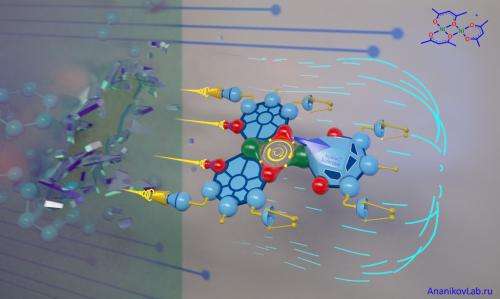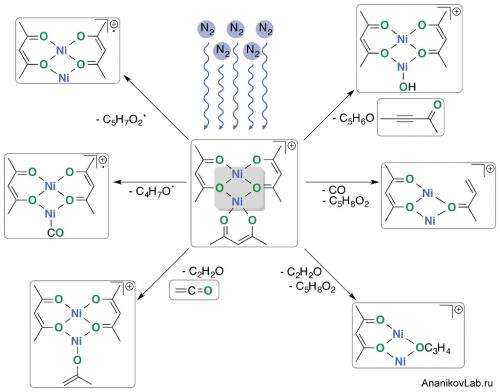Superatomic nickel core and unusual molecular reactivity

A superatom is a combination of two or more atoms that form a stable structural fragment and possess unique physical and chemical properties. Systems that contain superatoms open a number of possibilities for not only formation of new materials, but also for revealing unusual chemical reactivity. Throughout a given chemical transformation process, a superatom acts as a single unit and is left unchanged during the reaction. As a result, it would be logical to consider superatoms as elements of the periodic table in a nanoscale world. Potential areas of application for superatoms are quite broad – currently, many research directions are being explored worldwide in catalysis, material sciences, organometallic chemistry, and medical research.
Modern computations make it possible to predict structures that may recognize a superatom and even describe some of its properties. However, there are currently no universal analytic tools for researchers to detect superatoms within complex molecular frameworks. Indeed, development of advanced experimental approaches to detect superatoms is a key question for future research. Due to the unusual composition of superatoms and the number of atoms involved (often mentioned as the "magic" number), experimental observations are facilitated. The higher relative stability of superatoms also helps to detect and separate them from other molecules.
Scientists of the Zelinsky Institute have suggested mass spectrometry as a suitable tool to study superatoms. In the course of the experiment, a solution was fed into the ionization chamber of the mass spectrometer through a thin capillary via syringe pump. The solution was aerosolized, and compounds were ionized under high voltage and became individually charged particles (Figure 1). The technique is based on a well-known process called electrospray ionization (ESI). Correspondingly, such conditions may induce the formation of particles containing superatomic cores, which are further identified in a collision with nitrogen molecules in the second part of the apparatus. By varying the parameters of the collision, it is possible to estimate the relative stability and to identify the most stable ions.

Extraordinary properties were revealed in the electrospray ionization mass spectrometry experiment for a solution of nickel salt, namely nickel(II) acetylacetonate. After a detailed analysis of the obtained spectra, the authors found a surprisingly stable ion Ni2(acac)3+, which contained the Ni2O2 core. During the bombardment of ions by nitrogen molecules (ESI-MS/MS experiment), it was possible to establish a series of relative stability, based on the number of nickel atoms that make up the ion: Ni2 >> Ni3 ≈ Ni1. In a series of experiments an interesting trend of exceptional stability of bimetallic complex compared to mono- and trimetallic complexes was observed.
Unusual chemical processes were revealed upon examination of the metal complex with Ni2O2 core that contains two atoms of nickel and three residues of acetylacetonate. In spite of diverse reactivity and several fragmentation pathways, the principal Ni2O2 core remained unchanged (Figure 2). From a chemical point of view, the most important features were found in the reactions occurring as a result of C-C, C-H and C-O bond activation – the key processes in terms of possible applications in organic chemistry and catalysis.
One of the priority targets of modern catalysis is a modification of the organic fragments (coordinated as ligands) that does not affect the active site of the catalyst. Numerous studies have shown that it is not a simple task, because carbon-carbon, carbon-oxygen and carbon-hydrogen bonds in organic fragments are usually stronger (and more difficult to break) compared to the weak donor-acceptor bonds in the coordination complexes.

Formation of the superatomic core in such systems provides a chance to totally change established opinions on what organometallic complexes are and how the reactivity can be tuned. New reactivity patterns would allow scientists to exploit new properties of well-known compounds and to solve chemical problems that previously seemed extraordinary.
Results of this study enhance understanding of fundamental principles of superatom chemistry and provide insights to develop new catalytic systems for fine organic synthesis. As Prof. Ananikov mentioned: "Nickel complexes are very cheap and readily available. Surprisingly, some nickel complexes have shown superior properties to much more expansive catalysts. We can expect more and more powerful catalytic applications of nickel complexes in the nearest future."
More information: "Exceptional Behavior of Ni2O2 Species Revealed by ESI-MS and MS/ MS Studies in Solution. Application of Superatomic Core to Facilitate New Chemical Transformations" Organometallics, DOI: 10.1021/om500637k
Provided by ResearchSEA


















